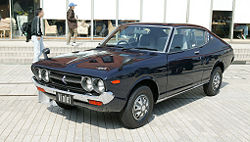- Nissan Stanza
-
- This article incorporates information from the equivalent article on the Japanese Wikipedia.
Nissan Stanza 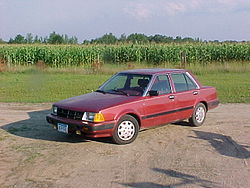
1983 Nissan Stanza (North American)Manufacturer Nissan Production 1977–1992 Assembly Hiratsuka, Japan
Oppama, JapanSuccessor Nissan Altima (USA)
Nissan Presea (Japan)
Nissan Primera (Europe)Class Compact The Nissan Stanza started out in Japan as the Nissan Violet in 1973, and then was split into two other models in 1977 called the second generation Nissan Auster and Nissan Violet . All three bore the A10 series identifier, and were built in Japan at Hiratsuka and Oppama, Incidentally, the series name A10 is also used by Toyota for the first generation Toyota Carina. A new third generation front-wheel drive model was launched in 1981, changing the series name again to T11, and shared the platform with the Compact MPV Nissan Prairie/Multi/Stanza Wagon. Final versions were Nissan Bluebirds series U12 rebadged for some international markets.
The Stanza/Auster/Violet were discontinued in 1992. The Stanza was replaced by the Nissan Altima in North America; the Stanza was replaced by the Nissan Primera in Japan.
Contents
710 series (1973–1977)
Nissan Violet 710 series
1973 Nissan Violet
Also called Yue Loong Violet (Yulon, TW)
Datsun 140J/160J
Datsun 710
Datsun Sedan
Datsun GuayinProduction Taiwan: 1971–1979
Japan: 1973–1977Body style 2-door hardtop coupe
4-door fastback
4-door sedan
4-door estateLayout FR layout Engine 2.0 L Straight-4 L20B
1.8 L Straight-4 L18
1.6 L Straight-4 L16
1.6 L Straight-4 L16P
1.4 L Straight-4 L14Transmission 3-speed automatic
5-speed manualWheelbase 2,450 mm (96 in) Length 4,120 mm (162 in) Width 1,580 mm (62 in) Height 1,375 mm (54.1 in) Curb weight 1,005 kg (2,220 lb) Before the Stanza, there was the (Japanese: Nissan Violet), a companion to the Datsun Bluebird 610, which sold outside Japan under Nissan's Datsun brand as the Datsun 140J/160J — except in the United States where it was the Datsun 710. This model was built as a 2-door saloon, 2-door coupé, 4-door fastback, 4-door notchback, estate, and van. The Violet was placed above the Datsun Sunny B210 but just slightly below the Datsun Bluebird-U 610. Introducing the Violet allowed Nissan to moderately increase the dimensions of the older Datsun Bluebird.
The sporty SSS model has rear independent suspension, others have leaf spring.
This car was assembled in Mexico from 1973 to 1978, and in the relevant markets was known as the Datsun Sedan and Datsun Guayin. It was offered with an optional 3-speed automatic gearbox for the model year 1978, previous years it was only available with the 4 speed manual transmission. It is sometimes referred to as the "bolillo" (white bread) because of its rounded design.
This car shared a platform but remained a rear wheel drive car with the new front wheel drive Nissan Cherry that was developed by Prince Motor Company before the Prince - Nissan merger in 1966.
This vehicle was available for sale around the same time as the first generation Toyota Carina.
In Taiwan the Violet was introduced in 1971 under the name Yue Loong Violet and replaced the successful Datsun Bluebird there for nine years. The VIP Brougham was a luxury version of the Violet with leather seats and wood interior. Official successor was the Yue Loong Elite 601 which was a sister model to the Nissan 200SX.
A10 series (1977–1981)
First generation 
Nissan Stanza (Japan-spec)
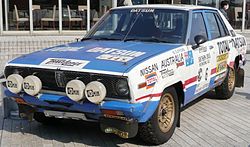
Nissan Violet "Southern Cross"Also called Nissan Auster
Nissan Violet
Datsun 510
Datsun Stanza
Datsun Violet
Datsun 160J
Yue Loong 709/711/712[1]Production 1977–1981 Successor (Japanese: Nissan AD) all A10 series wagons Body style 2-door saloon
3-door hatchback
4-door saloon
5-door hatchback (Stanza Resort)
5-door station wagonLayout FR layout Engine 2.0 L L20B I4
2.0 L Z20S I4
1.8 L L18 I4
1.8 L Z18E I4
1.6 L Z16S I4
1.6 L Z16E I4
1.6 L L16 I4
1.6 L L16S I4
1.6 L L16E I4Transmission 3-speed automatic
4-speed manual
5-speed manualWheelbase 94.5 in (2,400 mm) Length 169.9 in (4,315 mm) Width 63.0 in (1,600 mm) Height 54.7 in (1,389 mm) Curb weight 1,005 kg (2,220 lb) The Stanza, as it was known in some markets, was first introduced in the 1977 model year as a rebadged Japanese-market Nissan Violet A10 and a companion to the (Japanese: Nissan Violet Auster), which was sold at a different Nissan Japan dealership network. The Stanza, which is Italian for "room" or "apartment", was introduced as an affordable family car one level below the Nissan Laurel, with the companion Nissan Auster as a similar vehicle below the Nissan Skyline sedan, with the Stanza sold at Nissan Japan dealerships that sold the top level car Cedric.
According to the companion article at Japanese Wikipedia, "Auster" is derived from "Worster" which means "south wind". The Stanza was sold at dealerships that sold the Cedric and Laurel; the Auster was sold at dealerships that sold the Gloria and Skyline. The Violet was sold at dealerships that sold the Datsun Sunny and Datsun Bluebird.
In Australia, it was called the Datsun Stanza, and in Canada and the United States the Datsun 510, a name which recalled the successes of the previous Datsun 510. It was powered (in 1978 models) by the 2.0 L I4 L20B and in later years by the 2.0 L I4 Z20 series of engines.
Five body styles were on offer: 2- and 4-door saloons, a 3-door hatchback coupé (Nissan Violet), a 5-door hatchback (introduced later in the car's production run) and a 5-door estate. Transmissions offered were a 4-speed manual (in all except for the hatchback models), a 5 speed manual (hatchback models only), and a 3-speed automatic.
This vehicle was available for sale around the same time as the first generation Toyota Celica Camry and the Honda Accord.
Australia
The Stanza was assembled in Australia from 1978 to 1982, in 4-door 1.6 L saloon form, primarily to fill a gap between the Sunny and 200B. Trims available were "GL", "GX" and sporty "SSS".
While popular with buyers, the Australian Stanza was heavily criticized by the motoring journalists of the day (particularly Wheels Magazine), who regarded the car as being "unadventurous", particularly with regard to its styling and conventional drivetrain.
In 1979, 120 2-door coupé models were assembled in Australia, apparently due to a mix-up with Nissan Australia's kit ordering system.
New Zealand
New Zealand, as a result of the government's temporary lift of import licensing restrictions (the result of consumer demand for cars local CKD assemblers and built-up importers could not meet with the usual licensing restrictions and high import duties of up to 55%, plus sales tax up to 60%) saw considerable CBU imports of the Datsun 140J four-door sedan and 160J two-door during 1973 and 1974.
Due to the short notice and short timeframe of the licence requirement relaxation, the cars imported differed slightly in specification from shipment to shipment - some had Japanese market amber front park lights, front guard-mounted exterior rear view mirrors and 'Violet' badges; later units had clear lenses and 140J/160J badging.
Several hundred 140J sedans entered New Zealand through the Port of Timaru for the South Island market[2] and all were presold before they arrived.
All were keenly sought-after and hard to secure as they were better specified as standard (tinted glass, AM pushbutton radio, etc.) than the NZ-assembled CKD kit imported models, which consisted of the Datsun 1200 sedan and wagon, and 180B (Bluebird) and 260C (Cedric) sedans.
Almost-new 140Js were often resold soon after first registration for hundreds of dollars more than their retail prices, such was the model line's initial popularity.
The Japanese assembly quality of the 140J was better than the NZ-built Datsuns of the time which were assembled by outside assembly contractors - Nissan themselves did not open its own 'temporary' plant in Mt Roskill, Auckland, until the mid-1970s and a dedicated, purpose-built factory in Wiri in 1978.
In 1978, a further batch of 160J, in three-door hatchback form, were imported to New Zealand.
United Kingdom
In the United Kingdom, this generation was marketed as the Datsun Violet, and was sold in 1.4 L "GL" and 1.6 L "GL" engine/trim combinations. No estate models were offered.
Motorsports
The Violet 160J was Nissan's most successful car in the World Rally Championship. It won the Safari Rally in Kenya from 1979 to 1982 consecutively, all with Shekhar Mehta behind the wheel. The 1979 and 1980 winners were powered by an SOHC engine; the 1981 and 1982 winners were Violet GT models with a DOHC engine. These Safari records are only matched by the Toyota Celica GT-Four which won the 1992–95 events. Driven by Timo Salonen, the Violet also won the 1980 Rally New Zealand and the 1981 Rallye Côte d'Ivoire.
T11 series (1981–1986)
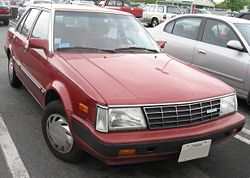
1984–86 (face-lifted) Nissan Stanza (North American)Also called Nissan Auster
Nissan VioletProduction 1982–1986 Body style 3-door hatchback (Auster)
4-door saloon
5-door hatchbackLayout FF layout Engine 2.0 L Straight-4 Z20E
1.6 L Straight-4 CA16S
1.8 L Straight-4 CA18DE
2.0 L Straight-4 CA20ETransmission 3-speed automatic
5-speed manualWheelbase 2,550 mm (100 in) Length 4,405 mm (173.4 in) Width 1,665 mm (65.6 in) Height 1,385 mm (54.5 in) Curb weight 970 kg (2,100 lb) Related Yue Loong Feeling 101/102, TW A front-wheel drive Stanza was introduced in 1981 — the first compact-class Datsun to be of that configuration.
After 1982, Nissan tried to standardize the Stanza name in its export markets — in addition to phasing out the Datsun marque in favour of Nissan. In the United States, the T11 Stanza with CA20S engine, replaced the 510 for the 1982 model year. The Nissan Prairie was also sold as part of the range, renamed the Stanza Wagon. In 1984, Nissan changed the engine in the Stanza from the carbureted CA20S to the fuel-injected 2.0 L, straight-4 CA20E. This car was 1981 Semperit Irish Car of the Year in Ireland.
3-door hatchback, 4-door saloon, and 5-door liftback models were produced. Japanese and some other export models were called "Stanza FX", and were offered with 1.6 and 1.8 L engines. The station wagon/delivery van was replaced by the Nissan AD van
This version was sold in the United Kingdom and Europe as the Nissan Stanza; the range was "L" 1.6 L, "GL" 1.6 L, "SGL" 1.6 L and "SGL" 1.8 L.
Nissan-Datsun New Zealand occasionally imported later generation Violets and other models for evaluation, or imported a small production run if additional import licences became available (there was a trading scheme enabling importers to trade unused annual license allocations with each other). One highly specified, five-door, third generation, front-drive model with automatic transmission - and then-rare air conditioning - was imported for an international distributors' conference held in NZ in 1981 and was later used by a company executive's wife before being resold through the company's own dealer network. There was also a small later shipment of cars for public sale (this time without a/c) but, as usual with low-volume imports of this type by Nissan and rivals, most were presold before the ship docked.
In Indonesia, the T11 Stanza 1.6 L was a popular car taxi in the mid-1980s.
The facelifted Japanese models have flat nose similar to the Bluebird U11 series. The Stanza was available in Japan as the Stanza as well as the (Japanese: Violet Liberto) sedan and 5-door hatchback, with the (Japanese: Liberta Villa) 3-door hatchback.
The Auster was a higher specification and sportier version of the Stanza, with the emphasis towards a younger demographic. The 3-door hatchback Auster GT-ES was equipped with a 5-speed manual transmission. Various trim packages were labeled, 1600CS-X, Auster JX, GS-X Extra, and the 1800GS-L Super Saloon.
In Taiwan a car closely based on the T11 Nissan Stanza got the name Yue Loong Feeling 101 and in a more luxury version Yue Loong Feeling 102. Both were available as a sedan and in a hatchback variant. The vehicles later got an aggressive redesign with angled headlights and more sporty rearlamps. These versions were the first indigenously developed Taiwanese cars and were even exported in small numbers.
The Stanza T11 series was the only time in history when Nissan Stanza was rated more reliable than Toyota Camry, from 1983 to 1986, according to 1983-1986 Consumer Reports magazine. Since 1987, Nissan has lost its ranking to Toyota and Honda.
T12 series (1986–1990)
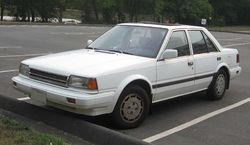
Nissan Stanza GXE

Nissan Bluebird (Stanza) 5-door hatchbackAlso called Nissan Auster
Nissan BluebirdProduction 1986–1990 Body style 4-door saloon
5-door hatchbackLayout FF layout Engine 2.0 L CA20S I4
2.0 L CA20E I4
2.0 L LD20 diesel I4
1.8 L CA18i I4
1.8 L CA18DE I4
1.8 L CA18ET Turbo I4
1.8 L CA18DET Turbo I4
1.6 L CA16S I4Transmission 4-speed automatic
5-speed manual
4-speed manualWheelbase 100.4 in (2,550 mm) Length 177.8 in (4,516 mm) Width 66.5 in (1,689 mm) Height 54.7 in (1,389 mm) Curb weight 1,220 kg (2,690 lb) Related Nissan Prairie/Axxess Nissan renewed the Auster and Stanza lines in 1986 (T12 series), introducing squared-off styling. Japan and the US received this model. The US Stanza used the same CA20E engine found in the previous generation. The car was unusually heavy for its class, and as a result of its small engine, underpowered.[3] In part to offset this, some export markets offered turbocharged models, badged "Supremo"; and a cousin, the "Auster XTT".
Europe received a version of the Nissan Auster as a Datsun/Nissan Bluebird replacement. These were built in Sunderland, in the United Kingdom, and badged as the Nissan Bluebird. The estate was the only "real" Bluebird in this range, imported from Japan.
The Stanza line was not seen in most other export markets after the 1986 model year. The growth of the Sunny and Pulsar models from below meant there was little room for it.
The T12 was introduced in Europe in 1985 as a replacement for the U11 Bluebird. From July 1986, the T12 was assembled from parts shipped in from Japan, at Washington, England. The saloon versions (four door) were available first and the hatchback (five door) became available in January 1987. Using the U11 platform, Bluebird Estates were also built at Washington.
The later T72 models replaced the T12 during 1987, followed by a face lift around a year later. This is a point to note, as it is a common mistake to class all pre face lift models as T12s. The face lift models had a more modern and European look, with round front and rear bumpers and the corporate slatted grill. These were eventually built entirely in England. In 1990, Nissan replaced the Bluebird with the Primera series. In the late 1980s and early 90s, Nissan Bluebirds were very commonly seen as taxis, their drivers racking up phenomenal mileage on just routine servicing. The bodyshell's resistance to corrosion has become legendary - it is not uncommon to see Bluebirds as old as 1987 or 1988 vintage still on British roads with virtually no trace of rust at all. However, the Bluebirds' reliability and all-around robustness has ultimately led to its demise – as a banger racers' car of choice.
Almost all petrol T12/T72 Bluebirds came with 8 valve versions of Nissan's CA Engine and either a 5 speed manual or a 4 speed automatic transmission. The diesel models used the normally aspirated LD20 engine. Performance was average for its class, the 1.6 struggling more with its lower torque characteristics that didn't seem suited to the weight of the car.
Although all but the most basic models were already well kitted out, the real pick of the crop from the Bluebird range were the Executive models. These had their own range of colours, Connolly Hide interior, body kit, lattice alloy wheels, air-conditioning and a vast array of standard equipment, even with electrically adjustable suspension (Executive Turbo, and T12 / pre-facelift Turbo models).
The turbo models used the CA18ET engine with 135 PS (99 kW; 133 bhp) giving a 0 - 60 mph (97 km/h) time of 8.6 seconds. This is the same engine used in the European Nissan Silvia S12. The incredibly strong nature of this engine allows enthusiasts to modify its power output to 200+ bhp without having to change the basic parts of the engine (cams, pistons, etc.). Front mounted intercoolers, larger turbochargers and higher capacity fuel injectors are vital parts in the 200 bhp+ challenge. For further power, the CA18DET double overhead cam turbo engine is a relatively simple swap, and the modding potential is increased further.
Please note, some of the early T12s shipped from Japan were available as a three door hatchback; these are now very rare. Also, some later European models were known to use 16 valve versions of the CA Engine.
U12 series (1990–1992)
Main article: Nissan Bluebird U12 U12 Nissan Stanza
U12 Nissan StanzaAlso called Nissan Bluebird
Nissan Pintara (AUS)
Yue Loong Bluebird 941 (Yulon, TW)Production 1990–1992 Successor Nissan Altima (North America)
Nissan Presea
Nissan PrimeraBody style 4-door saloon Layout FF layout Engine 2.4L KA24E I4 Transmission 4-speed automatic
5-speed manualWheelbase 100.4 in (2,550 mm) Length 1990-91: 4.57 m (179.9 in)
1992: 4.59 m (180.7 in)Width 1.70 m (66.9 in) Height 1.37 m (54.1 in) Related Nissan Prairie
Nissan MaximaIn the 1990 model year the American version of the Stanza was replaced by a basic version of the Nissan Bluebird (U12 series), wearing Stanza badges. In Japan and elsewhere, the Stanza and Auster ranges were effectively replaced by the Nissan Primera and the Nissan Presea for the 1990 model year.
The JDM Bluebird has rear license plate higher between the tail lights, whereas the Stanza's is mounted on the bumper.
The fourth generation Stanza was offered in two trim levels: "XE" and "GXE". The sporty SE model was added for 1992.
The 4th Gen Stanza used the 2.4 L inline-4 Nissan KA24E engine, an upgrade from previous generations in displacement (from 1974 cc to 2398 cc), power (from 94 hp (70 kW) to 138 hp (103 kW)), and torque (from 114 lb·ft (155 N·m) to 148 lb·ft (201 N·m)). The KA engine was not used on Japanese-spec Bluebirds.
The fourth generation Stanza has EPA estimated fuel economy of 18 mpg-US (13 L/100 km; 22 mpg-imp) city and 25 mpg-US (9.4 L/100 km; 30 mpg-imp) highway for the 4-speed automatic transmission. For the 5-speed manual transmission the Stanza has EPA estimated fuel economy of 18 mpg-US (13 L/100 km; 22 mpg-imp) city and 26 mpg-US (9.0 L/100 km; 31 mpg-imp) highway.[4]
The Stanza was discontinued after the 1992 model year and replaced by the American-built Altima, also Bluebird-based. The last American Stanza rolled off the assembly line on 27 March 1992, though its name would live on in the first generation Altima, technically known as the "Nissan Stanza Altima".
References
- ^ Braunschweig, Robert; Büschi, Hans-Ulrich, eds (March 6, 1980). Automobil Revue '80. 75. Berne, Switzerland: Hallwag, AG. pp. 534–535.
- ^ "Timaru's Artificial Harbour". Rootsweb. 2011-03-24. http://www.rootsweb.ancestry.com/~nzlscant/wharf.htm. Retrieved 2011-03-24.
- ^ "Maxima History". http://home.earthlink.net/~maxfaq/history.htm. Retrieved 2006-06-07.
- ^ "EPA Fuel Economy Site". http://www.fueleconomy.gov. Retrieved 2008-11-17.
External links
- Used Car Safety Ratings - Nissan Stanza
- RatDat.com - paint colors, sales brochures, and model names
- Multi-coupe 1977 model year Nissan AUSTER 1600CS-E・L
- Images of A10-AUSTERMARCHCOUPE Coupe 1977 model year Nissan Multi AUSTER
- 1985 model year Nissan AUSTER EUROFORM 1.8Si
- T12-AUSTER image
- GAZOO.com Nissan stanza (first)
- GAZOO.com Nissan stanza FX (2 of their 4-door)
- GAZOO.com Nissan stanza (3 DOORHATCHBACK second generation)
- GAZOO.com Nissan stanza (third generation)
Nissan road car timeline, United States and Canadian markets, 1980s–present Type 1980s 1990s 2000s 2010s 0 1 2 3 4 5 6 7 8 9 0 1 2 3 4 5 6 7 8 9 0 1 2 3 4 5 6 7 8 9 0 1 2 Subcompact Micra 210 Sentra Sentra Sentra Sentra Versa Versa Compact 310 Sentra Sentra 510 Stanza Stanza Stanza Altima Altima Leaf 810 Maxima Maxima Mid-size Altima Altima Maxima Maxima Maxima Maxima Full-size Maxima Sport compact Pulsar NX Pulsar NX NX 200SX 200SX 200SX 240SX 240SX Sports 280ZX 300ZX 300ZX 350Z 370Z GT-R (R35) Nissan Motor Company Vehicles Current370Z • Advan • Altima • Aprio • Armada • Atlas • Bluebird • Bluebird Sylphy • Cabstar • Caravan • Civilian • Clipper • Cube • Dualis • Elgrand • Frontier • Freeson • Fuga • GT-R • Juke • Lafesta • Leaf • Livina Geniss • Maxima • March • Murano • Moco • Navara • Note • NV200 • NV400 • Otti • Paladin • Pathfinder • Patrol • Qashqai • Quest • Rogue • Safari • Sentra • Serena • Skyline • Teana • Tiida • Titan • Urvan • Versa • Wingroad • X-Trail • XterraPastDC-3 • 100NX • 1200 • 310 • 180SX • 200SX • B-210 • 240SX • 240Z • 280ZX • 300C • 300ZX • 350Z • 510 • 810 • Almera • Almera Tino • Altra (EV) • Avenir • Auster • Bassara • Be-1 • Caball • Cablight • Cedric • Cefiro • Cherry • Cima • Crew • Datsun Truck • Echo • Expert • Fairlady • Figaro • Gazelle • Gloria • Hardbody Truck • Hypermini • Homy • Interstar • Junior • Largo • Laurel • Leopard • Liberty • Mistral • Multi • NX • Pao • Pintara • Pino • Platina • Prairie • Presage • Presea • Primera • President • Pulsar • Pulsar GTI-R • R390 GT1 • R'nessa • Rasheen • Roadster-Road Star • S-Cargo • Saurus • Saurus Jr • Silvia • Sileighty • Skyline GT-R • Stanza • Stagea • Sunny • Terrano • Terrano II • Vanette • VioletConcept126X • 216X • 270X • 300 Bambu • 315-a • AA-X • Actic • AD-1 • AD-2 • AL-X • Alpha T • Amenio • AQ-X • AP-X • ARC-X • AXY • AZEAL • Bevel • Boga • C-Note • Chapeau • Chappo • Cocoon • CQ-X • Crossbow • CUE-X • Cypact • Duad • Dunehawk • Effis • ESV • Evalia • EV Guide II • EV Truck • FEV • FEV-II • Foria • Forum • Fusion • Gobi • GR-1 • GR-2 • GT-R • ideo • Intima • Jikoo • Judo • Jura • Kino • KYXX • Land Glider • LEAF • LUC-2 • MID4 • Mixim • mm.e • Moco • Nails • NCS • NEO-X • NRV-II • NX-21 • NV2500 • Pivo • Pivo 2 • Qazana • Redigo • Round Box • Serenity • Sport Concept • Stylish VI • Terranaut • Tone • Townpod • Trailrunner • TRI-X • URGE • UV-X • XIX • XVL • Yanya • ZarootEngines GRX-3 • UD12 • VRT35Marques Nissan • InfinitiSubsidiaries
and divisionsSee also ATTESA • Datsun • HICAS • Prince • Renault-Nissan Alliance • Nissan Shatai • UD Nissan Diesel • VVL • VVEL • dCi
 Category ·
Category ·  CommonsCategories:
CommonsCategories:- Nissan vehicles
- Compact cars
- Sedans
- 1970s automobiles
- 1980s automobiles
- 1990s automobiles
- Vehicles introduced in 1977
- Front wheel drive vehicles
- Rear wheel drive vehicles
Wikimedia Foundation. 2010.

